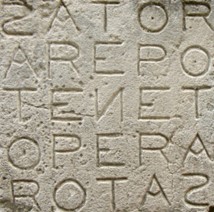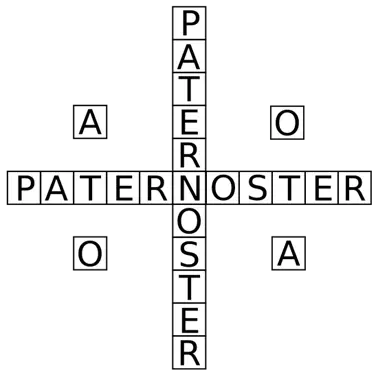Ancient Roman Palindrome
The Sator Square (or Rotas Square) is a two-dimensional palindrome made up of five Latin words: Sator (seeder, farmer), Arepo (a proper name), tenet (he holds), opera (as works), rotas (wheels). The most popular translation of this phrase is “The farmer Arepo has wheels as his work,” referring to the farmer’s usage of a plow. The inscription was found in the ruins of Pompeii and appears as a frequent motif in Christian architecture and art.

Palindromes have long held a magical significance in ancient societies that utilized writing systems. In medieval Christian thought, palindromes were seen as being protective against the devil. Traditional prayers used in exorcism can also be crafted from the letters used in the Sator Square, such as retro satana, toto Opere asper (back, Satan; terrible in [your] works).
The letters in the Sator Square can also be rearranged to form the incipit of the Lord’s Prayer, along with Alpha and Omega (pictured below). Early Christians may have used the Sator Square and its association with Christian imagery as an early way of identifying each other in times when Christianity was condemned by the Roman Empire.

» Amulet
» Ajna
» Arsenic
» Merkaba
» Hung
» Yin Yang
» bindi
» IK Onkar
» Khanda
» Halo
» jiahu
» Tau
» Uraeus
» Menorah
» Quincunx
» Tilaka
» Taijitu
» Vajra
» Chai
» Chi Rho
» Bagua
» Dragon
» Hunab Ku
» Caduceus
» Infinity
» Ichthus
» Hedjet
» Lauburu
» Om
» Ankh
» Chalice
» Pentacle
» Maat
» Ogham
» Mandala
» Kartika
» Khamsa
» Heart
» Labrys
» Sun Face
» Raven
» Triskele
» Scarab
» Dove
» Hanukia
» Anubis
» Trishula
» Durga
» Mezuzah
» Bay Tree
» Geruda
» Kinnara
» Quito
» Condor
» Blue Jay
» Falcon
» Makara
» Rosary
» Uluru
» Apsaras
» Hanuman
» Serpent
» Minotaur
» Mercury
» Apex
» Vestra
» Yoni
» Astarte
» dakini
» Calabash
» Mandrake
» Rebis
» Typhon
» Vegvísir
